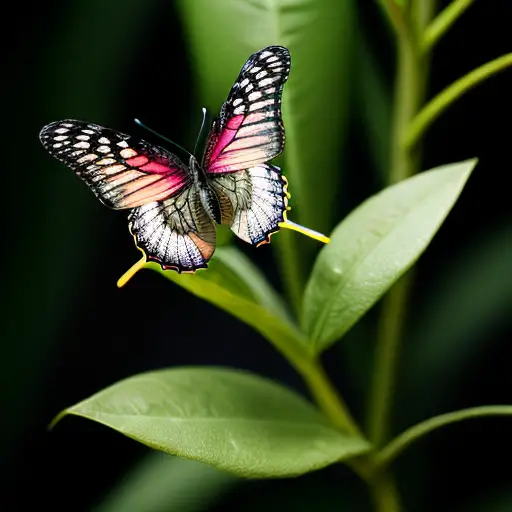Choosing the Perfect Butterfly Plant: A Guide to Selecting the Right Species
Are you ready to embark on a whimsical journey into the world of butterfly plants? Well, hold onto your gardening gloves because we're about to dive into the nitty-gritty of selecting the perfect species for your fluttery friends. First things first, you'll want to consider the climate in your area. Butterflies, much like divas, have their preferences, so make sure to choose a plant that can handle the heat or the chill. Next up, think about the size of your garden. Do you want a petite plant that fits snugly in a cozy corner, or are you dreaming of a grand spectacle that will make your neighbors green with envy? Lastly, don't forget about the nectar! Butterflies have a sweet tooth (or should we say sweet proboscis?), so opt for plants that produce nectar-rich flowers. With these tips in mind, you'll be well on your way to creating a butterfly paradise that will make even the most discerning Lepidoptera swoon with delight.
Planting and Establishing Your Butterfly Garden: Tips for Optimal Growth
An interesting fact about caring for butterfly plants is that they thrive on a diet of rotten fruit! While butterflies are known for their love of nectar, they also require additional nutrients to support their growth and reproduction. One way to provide these essential nutrients is by placing overripe fruits, such as bananas or oranges, near the butterfly plant. As the fruits decompose, they release sugars and minerals that attract butterflies, providing them with a supplementary food source. This unique feeding habit not only helps butterflies flourish but also adds a touch of natural beauty to your garden as these graceful creatures gather around the decaying fruit.
Ready to dig in and create a butterfly garden that will make your winged visitors feel like they're on cloud nine? Let's get planting! First off, choose a sunny spot in your garden, as butterflies love to bask in the warm rays of the sun. Next, prepare the soil by adding organic matter and ensuring it's well-drained – butterflies aren't fans of soggy feet! When it comes to selecting plants, opt for a variety of species that bloom at different times throughout the season, ensuring a continuous buffet of nectar for your fluttery friends. Remember to water your plants regularly, especially during dry spells, and keep an eye out for any pesky pests that might try to nibble on your precious plants. With a little TLC and some patience, your butterfly garden will soon be a buzzing hub of activity, attracting these delicate creatures in droves. Get ready to witness nature's ballet unfold right in your own backyard!
Nurturing Your Butterfly Plant: Essential Care and Maintenance Practices

Nurturing your butterfly plant is like tending to a delicate dance partner – it requires a gentle touch and a keen eye for detail. To ensure optimal growth and a thriving habitat for your fluttery friends, here are some essential care and maintenance practices to keep in mind. First and foremost, watering is key. While butterflies love a sip of nectar, their plant companions prefer a moist but not waterlogged environment. Be sure to water your plants deeply and consistently, especially during dry spells, but avoid overwatering, as this can lead to root rot. Mulching around the base of the plant can help retain moisture and regulate soil temperature, creating a cozy haven for both plant and butterfly.
In addition to watering, regular pruning is essential for maintaining the health and beauty of your butterfly plant. Deadheading spent flowers not only keeps your garden looking tidy, but it also encourages the plant to produce more blooms, providing a continuous source of nectar for your winged visitors. Pruning also helps shape the plant and prevent overcrowding, allowing for better air circulation and reducing the risk of disease. Remember to use clean, sharp tools and sanitize them between cuts to prevent the spread of any potential pathogens.
Another crucial aspect of caring for your butterfly plant is fertilization. While butterflies may not appreciate a gourmet meal of fertilizer, your plant certainly will. Choose a slow-release, organic fertilizer specifically formulated for flowering plants, and apply it according to the package instructions. This will provide the necessary nutrients for robust growth and vibrant blooms, ensuring a bountiful buffet for your fluttery guests. However, be mindful not to over-fertilize, as this can lead to excessive foliage growth at the expense of flower production.
Lastly, keep a watchful eye for any signs of pests or diseases that may threaten the health of your butterfly plant. Aphids, caterpillars, and spider mites are just a few of the common culprits that may try to nibble on your precious plants. Regularly inspect the leaves and stems for any signs of infestation, and take appropriate measures to control the pests, such as using organic insecticides or introducing beneficial insects like ladybugs or lacewings. Additionally, practicing good garden hygiene, such as removing fallen leaves and debris, can help prevent the spread of diseases and discourage pests from taking up residence in your butterfly haven.
By following these essential care and maintenance practices, you'll be well on your way to nurturing a thriving butterfly plant and creating a haven that will attract and delight these enchanting creatures for years to come. So grab your gardening gloves, embrace your inner butterfly whisperer, and get ready to witness the magic unfold in your very own backyard.
Attracting and Supporting Butterflies: Creating a Welcoming Habitat for These Delicate Creatures
A fun fact about caring for butterfly plants is that they love to be pampered with 'butterfly spa treatments'! To create a relaxing atmosphere for these beautiful creatures, you can place a shallow dish filled with water and colorful pebbles near the plant. Butterflies will perch on the pebbles and sip water, enjoying their own little oasis. So, not only do butterfly plants bring joy to your garden, but they also provide a serene retreat for their fluttering friends!
Creating a welcoming habitat for butterflies is like rolling out the red carpet for these delicate creatures. In addition to caring for your butterfly plants, there are a few more steps you can take to attract and support these winged wonders. First, provide a water source. Butterflies love to sip on shallow puddles or damp sand, so placing a shallow dish filled with water in your garden will give them a refreshing spot to quench their thirst. Next, consider adding some host plants to your garden. These are the plants that caterpillars feed on, and by including them, you'll provide a safe haven for butterflies to lay their eggs and complete their life cycle. Lastly, create sheltered areas in your garden by planting shrubs or adding butterfly houses. These cozy nooks will offer protection from harsh weather and predators, giving butterflies a safe space to rest and roost. By combining these efforts with the care and maintenance of your butterfly plants, you'll create an irresistible haven that will attract and support these delicate creatures, turning your garden into a butterfly paradise.

